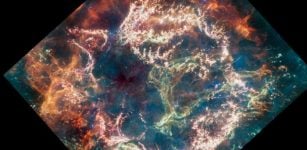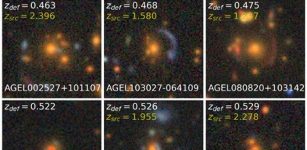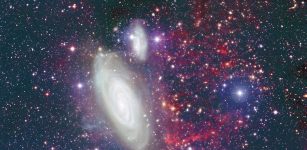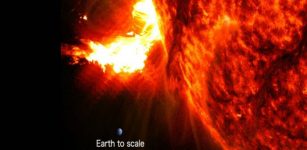The Puzzle Of Stellar Metal Pollution And Hungry White Dwarfs
Eddie Gonzales Jr. – MessageToEagle.com – The phenomenon of stellar metal pollution in white dwarfs has long baffled astronomers.
It is an intriguing enigma that demands study.
Planetesimal orbits around a white dwarf. Initially, every planetesimal has a circular, prograde orbit. The kick forms an eccentric debris disk which with prograde (blue) and retrograde orbits (orange). Credit: Steven Burrows/Madigan Group/JILA
The celestial bodies referred to as white dwarfs possess a remarkable characteristic – they harbor a mass comparable to that of our sun, yet their physical dimensions are akin to the Earth’s. These entities are prevalent in our galaxy, with 97% of stars ultimately transforming into white dwarfs. As stars approach the culmination of their life cycles, their cores undergo a gravitational collapse, condensing into the dense spherical form of a white dwarf.
This phenomenon lends our galaxy an ethereal semblance of a celestial graveyard.
However, astronomers have puzzled over the chemical makeup of these stellar remnants for years. The presence of heavy metal elements—like silicon, magnesium, and calcium—on the surface of many of these compact objects is a perplexing discovery that defies our expectations of stellar behavior.
“We know that if these heavy metals are present on the surface of the white dwarf, the white dwarf is dense enough that these heavy metals should very quickly sink toward the core,” explains JILA graduate student Tatsuya Akiba, in a press release.”
So, you shouldn’t see any metals on the surface of a white dwarf unless the white dwarf is actively eating something.”
While white dwarfs can consume various nearby objects, such as comets or asteroids (known as planetesimals), the intricacies of this process have yet to be fully explored. However, this behavior could hold the key to unraveling the mystery of a white dwarf’s metal composition, potentially leading to exciting revelations about white dwarf dynamics.
The researchers simulated the white dwarf receiving a “natal kick” during its formation (which has been observed) caused by asymmetric mass loss, altering its motion and the dynamics of any surrounding material.
They also examined the white dwarf’s dynamics after 100 million years, and found that the white dwarf’s nearby planetesimals still had elongated orbits and moved as one coherent unit, a result never seen before.
“This is something I think is unique about our theory: we can explain why the accretion events are so long-lasting,” states Madigan . “While other mechanisms may explain an original accretion event, our simulations with the kick show why it still happens hundreds of millions of years later.”
These results explain why the heavy metals are found on the surface of a white dwarf, as that white dwarf continuously consumes smaller objects in its path.
As Madigan’s research group at JILA focuses on gravitational dynamics, looking at the gravity surrounding white dwarfs seemed like a natural focus of study.
“Simulations help us understand the dynamics of different astrophysical objects,” Akiba says. “So, in this simulation, we throw a bunch of asteroids and comets around the white dwarf, which is significantly bigger, and see how the simulation evolves and which of these asteroids and comets the white dwarf eats.”
As Akiba elaborates, “Other studies have suggested that asteroids and comets, the small bodies, might not be the only source of metal pollution on the white dwarf’s surface. So, the white dwarfs might eat something bigger, like a planet.”
The discoveries illuminate the origin and future evolutionary trajectory of our solar system, with details about the underlying chemistry involved.
Madigan asserts, “The vast majority of planets in the universe will ultimately find themselves orbiting a white dwarf.”
“It is plausible that 50% of these systems, including our own solar system, may be consumed by their star. Now, we possess a mechanism to elucidate the rationale behind this phenomenon.”
“Planetesimals can give us insight into other solar systems and planetary compositions beyond where we live in our solar region” McIntyre adds. “White dwarfs aren’t just a lens into the past. They’re also kind of a lens into the future.”
Written by Eddie Gonzales Jr. – MessageToEagle.com Staff Writer
Related Posts
-
 Secrets Of Star Structure And Building Blocks Of Life – Revelead By JWST
No Comments | Apr 8, 2023
Secrets Of Star Structure And Building Blocks Of Life – Revelead By JWST
No Comments | Apr 8, 2023 -
 Giant Disrupted ‘Tadpole’-Shaped Galaxy – Discovered
No Comments | Nov 21, 2018
Giant Disrupted ‘Tadpole’-Shaped Galaxy – Discovered
No Comments | Nov 21, 2018 -
 Newly Discovered Gravitational Lenses Could Reveal Ancient Galaxies And The Nature Of Dark Matter
No Comments | Sep 26, 2022
Newly Discovered Gravitational Lenses Could Reveal Ancient Galaxies And The Nature Of Dark Matter
No Comments | Sep 26, 2022 -
 Earth-Based Telescopes In Chile Offer A Fresh Look At Cosmic Dawn
No Comments | Jun 12, 2025
Earth-Based Telescopes In Chile Offer A Fresh Look At Cosmic Dawn
No Comments | Jun 12, 2025 -
 Ancient Text Reveals Sighting Of SN 1006 – Brightest Supernova Ever Observed
No Comments | Apr 28, 2016
Ancient Text Reveals Sighting Of SN 1006 – Brightest Supernova Ever Observed
No Comments | Apr 28, 2016 -
 Aboriginal Legends Tell Millennia-Old Stories Of Events In The Sky
No Comments | Mar 6, 2015
Aboriginal Legends Tell Millennia-Old Stories Of Events In The Sky
No Comments | Mar 6, 2015 -
 Rotating Black Holes May Serve As Gentle Portals For Hyperspace Travel
No Comments | Jun 5, 2019
Rotating Black Holes May Serve As Gentle Portals For Hyperspace Travel
No Comments | Jun 5, 2019 -
 Gigantic Plume Of Gas 300,000 Light Years Across Discovered In Virgo Cluster Galaxy NGC 4569
No Comments | Feb 25, 2016
Gigantic Plume Of Gas 300,000 Light Years Across Discovered In Virgo Cluster Galaxy NGC 4569
No Comments | Feb 25, 2016 -
 Doomed Moons Of Uranus – Cupid And Belinda Are On Collision Course
No Comments | Aug 9, 2012
Doomed Moons Of Uranus – Cupid And Belinda Are On Collision Course
No Comments | Aug 9, 2012 -
 Solar Flares Over 6 Times Hotter Than Previously Thought
No Comments | Sep 10, 2025
Solar Flares Over 6 Times Hotter Than Previously Thought
No Comments | Sep 10, 2025

